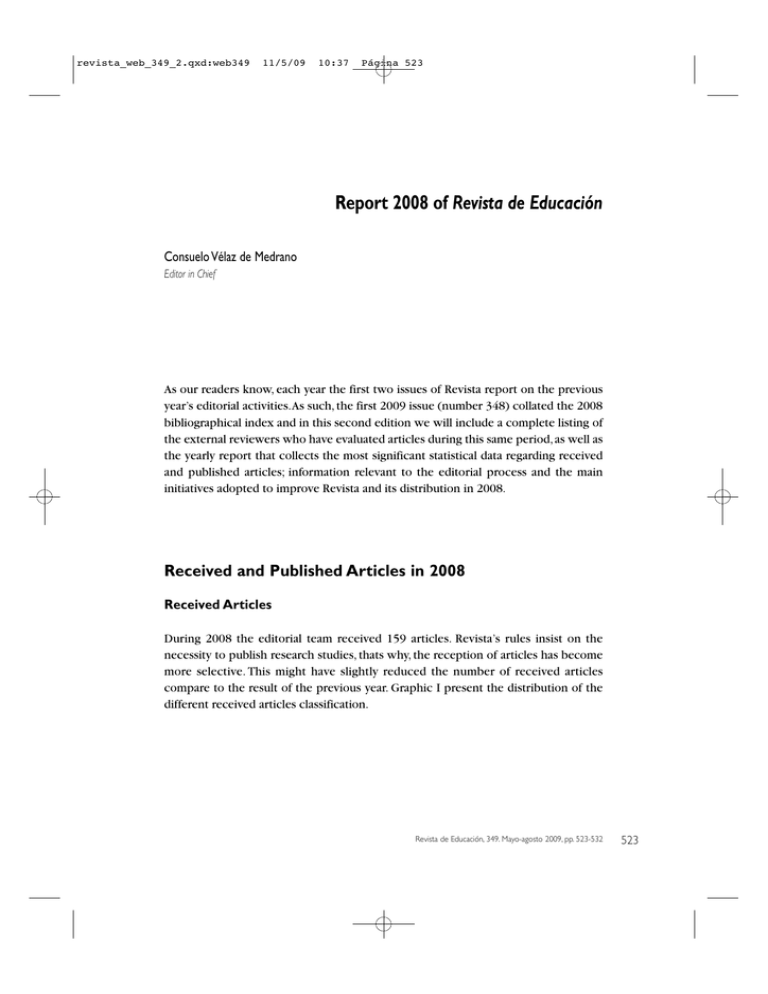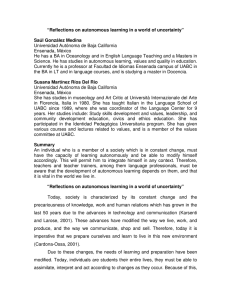Report 2008 of Revista de Educación
Anuncio

revista_web_349_2.qxd:web349 11/5/09 10:37 Página 523 Report 2008 of Revista de Educación Consuelo Vélaz de Medrano Editor in Chief As our readers know, each year the first two issues of Revista report on the previous year’s editorial activities. As such, the first 2009 issue (number 348) collated the 2008 bibliographical index and in this second edition we will include a complete listing of the external reviewers who have evaluated articles during this same period, as well as the yearly report that collects the most significant statistical data regarding received and published articles; information relevant to the editorial process and the main initiatives adopted to improve Revista and its distribution in 2008. Received and Published Articles in 2008 Received Articles During 2008 the editorial team received 159 articles. Revista’s rules insist on the necessity to publish research studies, thats why, the reception of articles has become more selective. This might have slightly reduced the number of received articles compare to the result of the previous year. Graphic I present the distribution of the different received articles classification. Revista de Educación, 349. Mayo-agosto 2009, pp. 523-532 523 revista_web_349_2.qxd:web349 11/5/09 10:37 Página 524 Vélaz de Medrano Ureta, C. REVISTA DE EDUCACIÓN 2008 ANNUAL REPORT GRAPH I. Classification of received articles in 2008 External Review Results: Articles accepted and declined Of the 159 articles received in 2008, 38% (60) were published this same year; 12% (19) were rejected; another 14% (23) were accepted and are pending publication in future editions; and finally 36.% (57) are still following the external review process due to being presented in the second half of the year (Graph II). GRAPH II. Breakdown of 2008 received articles. 524 Revista de Educación, 349. Mayo-agosto 2009, pp. 523-532 revista_web_349_2.qxd:web349 11/5/09 10:37 Página 525 Vélaz de Medrano Ureta, C. REVISTA DE EDUCACIÓN 2008 ANNUAL REPORT From the group of articles that have been accepted or are in the evaluation period (140), the large majority are research projects and studies, which is in keeping with the type of articles received and the nature of Revista (Graph III). GRAPH III. Classification of accepted articles (2008) Lastly, we should point out that practically all accepted articles were, in the first instance, provisionally accepted (in 92% of the cases, as shown in Graph IV) pending the inclusion of suggestions or proposed modifications made in the external reviewer’s reports. GRAPH IV. Percentage of accepted with articles an without modifications Revista de Educación, 349. Mayo-agosto 2009, pp. 523-532 525 revista_web_349_2.qxd:web349 11/5/09 10:37 Página 526 Vélaz de Medrano Ureta, C. REVISTA DE EDUCACIÓN 2008 ANNUAL REPORT Published Articles The tally of published works includes both received articles as well as those commissioned by Revista and proposed by either the co-ordinator or guest editor for this end. It also includes those accepted following specific calls for papers. All the articles were submitted to the external review. During 2008, 71 articles were published in the three normal editions and the one special edition of the Revista.Table I shows the number and section of published works. TABLE I. 2008 Published Works Sent by authors Research projects and studies Essays and reports Educational experiences (innovation) Edition Commissioned by the journal (monographic and special topics) 345 7 9 3 1 20 346 5 11 3 1 20 10 2 1 20 3 71 347 7 Special issue 11 Total 30 Total Without classification 30 8 11 In Graph V one can see that the majority of published articles in the journal’s normal editions correspond to the research section. GRAPH V. Number of published articles in normal editions and their corresponding classification (2008) 526 Revista de Educación, 349. Mayo-agosto 2009, pp. 523-532 revista_web_349_2.qxd:web349 11/5/09 10:37 Página 527 Vélaz de Medrano Ureta, C. REVISTA DE EDUCACIÓN 2008 ANNUAL REPORT As is normal, commissioned articles are published in the monographic section of both normal and special editions. During 2008 these have dealt with the areas of interest detailed in Table II and were co-ordinated by different specialists (guest editors). TABLA II. Topics dealt with by single authors (2008) Edition 345 Edition 346 Edition 347 Special issue From Immigrant to Minority: Themes and Problems in Multicultural Societies Guest Editor: Mariano Fernández Enguita y Eduardo Terrén (Universidad de Salamanca). The Analysis of the Pupil-Teacher Interaction: Researching Lines Guest Editor: César Coll (Universidad de Barcelona) y Emilio Sánchez (Universidad de Salamanca). Sociocultural attention to the rights of early childhood Guest Editor: Mª Paz Lebrero Baena (Universidad Nacional de Educación a Distancia). Times of university change in Europe Guest Editor: Francisco Michavila (Universidad Politécnica de Madrid). The Editorial Process: management, review and publication of works In 2008’s first edition (345), the time required from start to finish for the editorial process was one year and five months. In the second edition (346) and third edition (347) this was reduced by 2 months; and finally, in the «special edition», the time required was eight months and fifty days (Graph VI). GRAPH VI. Average time (days) between reception, acceptance and publications (2008) Revista de Educación, 349. Mayo-agosto 2009, pp. 523-532 527 revista_web_349_2.qxd:web349 11/5/09 10:37 Página 528 Vélaz de Medrano Ureta, C. REVISTA DE EDUCACIÓN 2008 ANNUAL REPORT Bearing in mind these timeframes, one must consider the volume of papers published by Revista de Educación (an average of 22 each edition, which is far more than the average number published by other Spanish scientific journals in this area). Revista de Educación takes articles to press in the 4th edition after their full acceptance. If we consider that it is an objective of Revista to maintain a high volume of quality, published works, whilst bearing in mind the rigorous and demanding review process, we positively value this indicator’s evolution. Notwithstanding, there is a part of the process that still must and can be improved: The time between the reception and provisional acceptance of an article following its first external review. GRAPH VII. Average time (in days) between definitive acceptance and its publication It is certain that in the total time taken to publish an article, the revision process plays a decisive role. Bearing in mind it is a complex process that must be performed with the necessary guarantees (every article is evaluated by at least 2 external reviewers, according to a double blind rule) there are three actors who play a role: the Revista de Educación; the external reviewers (2 or 3); and the article’s authors.Whilst Revista is responsible for speeding up the process with respect to the management and work of its external reviewers, it is also the responsibility of each article’s authors to manage and reduce the occasionally excessive time taken to make the requested changes as per the reviewers’ reports (Graph VII). 528 Revista de Educación, 349. Mayo-agosto 2009, pp. 523-532 revista_web_349_2.qxd:web349 11/5/09 10:37 Página 529 Vélaz de Medrano Ureta, C. REVISTA DE EDUCACIÓN 2008 ANNUAL REPORT In this regard, it should be pointed out that the average time taken by the reviewers in 2008 has been greater than that established by the Revista de Educación, although it must be borne in mind that this average has been affected by the fact that eighteen articles were evaluated by three reviewers (so as to settle disagreements that came about as a result of the first two evaluations) and another twelve papers went through three review rounds before being finally accepted. The time dedicated to these 31 papers increases the total average external review period, whilst if they were excluded, the average time would not be even two months. To conclude, by the end of the year the review periods have been considerably reduced as a result of the application of two measures: The steadily increasing number of external reviewers available for Revista (nowadays 216 specialists collaborate across different educational topics and areas). Lastly, we will see that the average time between final acceptance and publication varies depending on an article’s classification (Graph VIII). GRÁFICO VIII. Average time (in days) between acceptance and publication according to topic In the monographic (Special Topics) the period was about three months at the end of 2008,nine months for research section, thirteen for for essays o report, and five for innovative experiencies. This difference is due to the weighting given to the different sections of Revista de Educación whose fundamental aim is the publication of articles that communicate the results of new and original investigation. Due to its repercussions, the rules of Revista duly note this point for potential authors of essays, reports and experiences. Revista de Educación, 349. Mayo-agosto 2009, pp. 523-532 529 revista_web_349_2.qxd:web349 11/5/09 10:37 Página 530 Vélaz de Medrano Ureta, C. REVISTA DE EDUCACIÓN 2008 ANNUAL REPORT Readership of relevant papers in the area of education During 2008, 41 reviews of noted papers were published (according to the topic and journal’s prestige) that were edited between 2007 and 2008 (Graph IX).These include the reviews received and requested by Revista, according to the journal’s own rules. GRAPH IX. Number of 2008 published reviews 2008 It has also been published a total of 61 bibliographic references of a selection of some of the best papers sent to the editorial team by both Spanish and international publications (selected by the journal’s quality). Both the reviews and the references have been published according to the order in which they were received by the editorial team. GRAPH X. 2008 published bibliographic references 530 Revista de Educación, 349. Mayo-agosto 2009, pp. 523-532 revista_web_349_2.qxd:web349 11/5/09 10:37 Página 531 Vélaz de Medrano Ureta, C. REVISTA DE EDUCACIÓN 2008 ANNUAL REPORT Follow-up of the editorial strategy started in 2005 In 2008 the process of aligning Revista with the most demanding quality indicators of scientific journals in social sciences has continued. In 2008 Revista de educación was evaluated by the Institute of Scientific Information (ISI-Thomson) and was included in a Social Sciences Citation Index (SSCI)® A group of measures have been undertaken in order to improve the impact factor of the Revista de Educación, especially in international area. This has especially implied, working to incorporate guess editors and authors, relevant articles with impact factor and try to be indexing in new databases. In 2008 Revista de Educación has been indexed in new bibliographic databases: I National databases: BEG (Gencat), DICE (Difusión y Calidad Editorial de las Revistas Españolas de Humanidades y Ciencias Sociales y Jurídicas) y REDINED (Red de Bases de Datos de Información Educativa). I International databases: Social Sciences Citation Index® (SSCI), Social Scisearch®, Journal Citation Reports/Social Sciences Edition, European Reference Index for the Humanities (ERIH), Ulrich’s Periodicals Directory. Distribution of Revista The Revista is distributed by both individual and institutional subscription; by sales made via the Ministerio de Educación, Política Social y Deporte (Spain) Departmento de Información y Publicaciones; and by the exchange with other prestigious national and international educational journals which contributes to increase the Ministerio de Educación, Política Social y Deporte library funds. Revista de Educación, 349. Mayo-agosto 2009, pp. 523-532 531 revista_web_349_2.qxd:web349 11/5/09 10:37 Página 532 Vélaz de Medrano Ureta, C. REVISTA DE EDUCACIÓN 2008 ANNUAL REPORT I I I I PRINTED COPIES: 15001 copies. SUBSCRIPTIONS: 344 copies. FREE DISTRIBUTION TO INSTITUTIONS: 500 copies. EXCHANGE WITH PRESTIGIOUS NATIONAL AND INTERNATIONAL JOURNALS: 114 copies (63 Spanish journals, 15 with European and North American journals, 36 with Ibero-American journals). PUBLIC RETAIL PRICE: Annual suscription España EU 13€ 28€ 37€ Resto del mundo 37€ THE ELECTRONIC VERSION IS FREE Likewise, advertising is included in professional journals and educational periodicals with the aim of promoting the published works not only via scientific channels but also between members of the educational community. Lastly, it must be pointed out that the first issue (345) in 2008 From Immigrant to Minority: Themes and Problems in Multicultural Societies and the special edition Times of university change in Europe was presented in two government research offices: the Consejo Escolar del Estado and the Consejo Superior de Investigaciones Científicas (CSIC), respectively. Numerous specialists and researchers from the area of Educational History attended this event. The work undertaken in 2008, and which is the topic of this report, allows us to hope for important achievements for Revista de Educación by its meeting the highest publishing standards; the material covered; its national and international representation; and, decisively, the impact of the authors´ work it publishes. (1) 532 There was a decline in printed copies circulation, compared to the year 2007, produced by the increase of readers in the electronic version which access is free. Revista de Educación, 349. Mayo-agosto 2009, pp. 523-532


